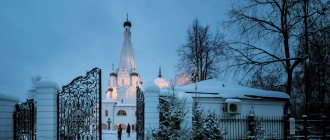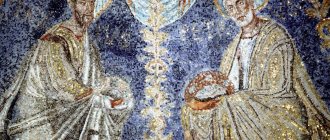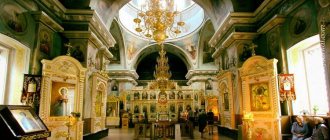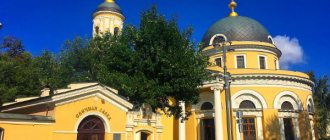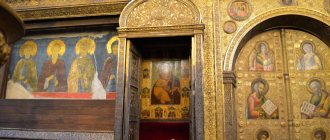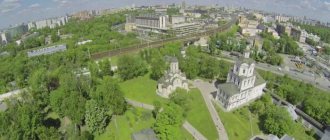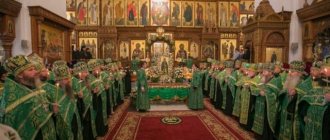Mir
Russia Moscow Temple of the Apostles Peter and Paul at the Yauz Gate (Moscow) Map is loading...
{"format":"leaflet","minzoom":false,"maxzoom":false,"limit":50,"offset":0,"link":"all","sort":[""], "order":[],"headers":"show","mainlabel":"","intro":"","outro":"","searchlabel":"\u2026 \u0441\u043b\u0435\ u0434\u0443\u044e\u0449\u0438\u0435 \u0440\u0435\u0437\u0443\u043b\u044c\u0442\u0430\u0442\u044b","default":"","import-annotation":false,"width ":"auto","height":"350px","centre":{"text":"","title":"""link":"","lat":55.7511099999999970577846397645771503448486328125,"lon": 37.64332999999999884721546550281345844268798828125,"icon":""},"title":"","label":"","icon":"","lines":[],"polygons":[],"circles":[ ],"rectangles":[],"copycoords":false,"static":false,"zoom":8,"defzoom":14,"layers":["OpenStreetMap"],"image layers":[] ,"overlays":[],"resizable":false,"fullscreen":true,"scrollwheelzoom":true,"cluster":false,"clustermaxzoom":9,"clusterzoomonclick":true,"clustermaxradius":80, "clusterspiderfy":true,"geojson":"","clicktarget":"","showtitle":true,"hidenamespace":false,"template":"","userparam":"","activeicon": "","pagelabel":false,"ajaxcoordproperty":"","ajaxquery":"","locations":[{"text":"\u003Cb\u003E\u003Ca href=\"/palomnik/%D0% A5%D1%80%D0%B0%D0%BC_%D0%B0%D0%BF%D0%BE%D1%81%D1%82%D0%BE%D0%BB%D0%BE%D0%B2_% D0%9F%D0%B5%D1%82%D1%80%D0%B0_%D0%B8_%D0%9F%D0%B0%D0%B2%D0%BB%D0%B0_%D1%83_%D0% AF%D1%83%D0%B7%D1%81%D0%BA%D0%B8%D1%85_%D0%B2%D0%BE%D1%80%D0%BE%D1%82_(%D0%9C %D0%BE%D1%81%D0%BA%D0%B2%D0%B0)\» title=\»\u0425\u0440\u0430\u043c \u0430\u043f\u043e\u0441\u0442\u043e\u043b\ u043e\u0432 \u041f\u0435\u0442\u0440\u0430 \u0438 \u041f\u0430\u0432\u043b\u0430 \u0443 \u042f\u0443\u0437\u0441\u043a\u0438 \u0445 \u0432\u043e\u0440\u043e\ u0442 (\u041c\u043e\u0441\u043a\u0432\u0430)\»\u003E\u0425\u0440\u0430\u043c \u0430\u043f\u043e\u0441\u0442\u043e\u043b\u043e \u0432 \u041f\u0435\ u0442\u0440\u0430 \u0438 \u041f\u0430\u0432\u043b\u0430 \u0443 \u042f\u0443\u0437\u0441\u043a\u0438\u0445 \u0432\u043e\u0440 \u043e\u0442 (\u041c\u043e\u0441 \u043a\u0432\u0430)\u003C/a\u003E\u003C/b\u003E\u003Chr /\u003E\u003Ca href=\"/palomnik/%D0%A1%D0%B2%D0%BE%D0%B9% D1%81%D1%82%D0%B2%D0%BE:%D0%90%D0%BD%D0%BD%D0%BE%D1%82%D0%B0%D1%86%D0%B8%D1 %8F\" title=\"\u0421\u0432\u043e\u0439\u0441\u0442\u0432\u043e:\u0410\u043d\u043d\u043e\u0442\u0430\u0446\u0438\u044f\"\u003E\u04 10\ u043d\u043d\u043e\u0442\u0430\u0446\u0438\u044f\u003C/a\u003E: "'\u0425\u0440\u0430\u043c \u0441\u0432\u044f\u0442\u044b\u04 45\u0430\u043f\u043e \u0441\u0442\u043e\u043b\u043e\u0432 \u041f\u0435\u0442\u0440\u0430 \u0438 \u041f\u0430\u0432\u043b\u0430 \u0443 \u042f\u04 43\u0437\u0441\u043a\u0438\u0445 \u0432\u043e\u0440\u043e\u0442"' (\u043d\u0430 \u041a\u0443\u043b\u0438\u0448\u043a\u0430\u0445) \u2014 \u043f\u0440\u0430\u 0432\u043e\u0441\u043b \u0430\u0432\u043d\u044b\u0439 \u0445\u0440\u0430\u043c \u041f\u043e\u043a\u0440\u043e\u0432\u0441\u043a\u043e\u0433\u043e \u0431\u043b\u0430\u0433\u043e \u0447\u0438\u043d\u0438\u044f \u041c\u043e\u0441\u043a\u043e\u0432\u0441\u043a\u043e\u0439 \u0433\u043e\u0440\u043e\u0434\ u0441\u043a\u043e\u0439\u0435 \u043f\u0430\u0440\u0445\u0438\u0438. \u041f\u043e\u0434\u0432\u043e\u0440\u044c\u0435 \u041f\u0430\u0442\u0440\u0438\u0430\u0440\u0445\u0430 \u041c\u043e\u0441\ u043a\u043e\u0432\u0441\u043a \u043e\u0433\u043e \u0438 \u0412\u0441\u0435\u044f \u0420\u0443\u0441\u0438; \u041f\u043e\u0434\u0432\u043e\u0440\u044c\u0435 \u0421\u0435\u0440\u0431\u0441\u043a\u043e\u0439 \u041f\u0440\u0430\u0432\ u043e\u0441\u043b\u0430\u0432 \u043d\u043e\u0439 \u0426\u0435\u0440\u043a\u0432\u0438.","title":"\u0425\u0440\u0430\u043c \u0430\u043f\u043e\u0441\u0442\u043e \u043b\u043e \u0432 \u041f\u0435\u0442\u0440\u0430 \u0438 \u041f\u0430\u0432\u043b\u0430 \u0443 \u042f\u0443\u0437\u0441\u043a\u0438\u04 45\u0432\u043e\u0440\u043e\u0442 (\u041c\u043e\u0441\u043a\u0432\u0430)","link":"","lat":55.7511099999999970577846397645771503448486328125,"lon":37.643329999999998847 21546550281345844268798828125,"icon":""}],,"imageLayers":[] }
55.751052; 37.643138
Russia, Moscow, Petropavlovsky lane, 4-6с3
Moscow
Russia
Telephone:
(495) 917 29 75,, 916-06-27, (495) 917 80 36
Church of the Holy Apostles Peter and Paul at the Yauza Gate
(on Kulishki) - Orthodox church of the Intercession Deanery of the Moscow City Diocese. Metochion of the Patriarch of Moscow and All Rus'; Metochion of the Serbian Orthodox Church.
History[edit]
The temple on this site has been there since ancient times and had the name “Peter and Paul Tall, on the Hill.” The first stone church was commemorated in 1631. Evidence has been preserved that His Holiness Patriarch of Moscow and All Rus' Adrian in March 1693 held a funeral service for Vassa Stroganov in the church. With the blessing of His Holiness, a house church in the name of the Kazan Icon of the Mother of God was built in the parish of the Peter and Paul Church, built in 1698 at the house of General Fyodor Golovin (“stone with ringing”).
1882
With the blessing of His Holiness the Patriarch, the old stone church was dismantled and a new one was built in 1700-1702, which still stands to this day. The main altar of the new church was consecrated in honor of the icon of the Mother of God “The Sign”, and for the old altar in the name of St. ap. Peter and Paul on the north side arranged a special warm winter limit. The patrons and temple builders of the new church were old parishioners from the Eropkin and Kolychev families. The main expenses were covered by Vasilisa Eropkina. The issuance of the antimension to the newly built church took place on January 1, 1702. The architectural style of the new temple belongs to the “Moscow Baroque”.
In 1731, a special Kazan border was built in the church on the southern side and the temple became three-altar. The throne was consecrated on October 13, 1731 by the archpriest of the Great Assumption Cathedral, Ioann Maximov. The temple was badly damaged by the Moscow fire of 1748, but was quickly restored with the help of parishioners. A significant event in the Peter and Paul Parish was the construction in 1771 of a new three-tier bell tower, which took a long time to construct due to the plague epidemic and strict quarantine. From the entry of Apoleon's hordes into Moscow, looting and fires in 1812, the temple itself suffered less than the nearest churches, and after consecration two parish churches were temporarily assigned to it (St. Nicholas in Podkopayi and the Three Saints in Kulishki). The church buildings and the clergy's own houses were all burned. There were never apartment buildings near the church, but clergy lived in church buildings on church land. Of the currently existing buildings, in chronological order, the following were built: in 1830 - a stone 2-story priest's house with mezzanines. Rebuilt in 1888 according to the design of V.N. Korneev; in 1853 according to the design of the architect N.N. Elagin built a 2-story stone deacon's house; in 1879, according to the design of the architect S. Sonin, a 2-story building was built - the house of the sexton and prosphyr.
After the revolution, a real threat of closure hung over the temple, because... this was demanded by the local detachment of pioneers, calling for the transfer of the temple building to their needs. Despite many resolutions of Soviet authorities, by the grace of God the temple was not closed. There was no renovationist schism in the church either. On Easter 1946, immediately after the end of the night liturgy, the long-time rector of the church, Archpriest Arkady Ponomarev, beloved by the parishioners, quietly died in the altar. In 1948, with the blessing of His Holiness Patriarch Alexy I of Moscow and All Rus', a courtyard of the Serbian Orthodox Church was opened at the temple, which actually did not begin to operate for political reasons. By decree of His Holiness Patriach of Moscow and All Rus' Alexy II of December 31, 1999, the Church of St. ap. Peter and Paul was transformed into the Patriarchal Metochion, at which the representation of the Serbian Orthodox Church was resumed.
Current state
Only in 1992 was the practically collapsing building returned to the Church. Restoration here is still ongoing. However, not only a parish has already developed here, but also a special atmosphere of prayer and love.
This is what parishioner Julia says about it: “A stunning temple! The most beloved in Moscow! Unusual architecture, extraordinary beauty and grace, very good priests! You come here, but your legs won’t go back, as if they’re growing into the floor! I love!!!".
And here is the opinion of another woman who comes here not so often (spelling preserved):
“I love this Temple very much, even despite the fact that there is no renovation in it. I hope that funds will be found for its restoration. It is so calm, pleasant, cozy and after visiting there is such peace in the soul. During Great Lent, Unction takes place there. Everything here is clearly organized, I’ve been to several churches, and this is the best. I come and rest my soul. The Bright Temple in the literal and figurative sense. We always come here for holy water. With all my heart I wish prosperity to this Temple, and God help all the servants.”
Shrines[edit]
Icon of St. Nicholas the Saint of the Peter and Paul Church
- Altar cross with the relics of the holy saints of God of the Universal Church.
- Ark with the relics of the saints of the Universal Church.
- Bogolyubskaya Icon of the Mother of God.
- Icon of St. Nicholas of Myra, in whose panagia are the relics of St. Neil of Stolobensky.
- Icon of the Baptist John with relics and hoop.
- Icons of the blessed Matrona of Moscow, St. Alexis of Moscow, St. Sisoes the Great, St. Lazarus of Serbia, St. John of San France with the relics of these holy saints of God.
- Hilandar Icon of the Mother of God “Three-Handed”, image of the Mother of God “Seeking the Lost”.
Interiors
The rich three-nave temple resembles a luxurious ceremonial hall. Powerful marble-painted columns support the vaults. The floor is made of limestone slabs, and the interior decoration uses pink rhodonite, multi-colored marble and ornamental jasper. The decoration of the walls was done by artists Negrubov and Vorobyov, and the elegant stucco work was done by Italian masters Antonio Quadri and Ignazio Rossi.
Bell tower of the Peter and Paul Cathedral
Five large chandeliers fill the interior spaces with even light. The lamps are made of gilded bronze, rock crystal and Venetian glass. The original chandelier from the 18th century hangs in front of the altar, and the other four are copies that were restored in the post-war period.
Everyone who finds themselves in the cathedral is amazed by the huge iconostasis, 20 m high. It was carved in the 1720s according to the drawings of Dominico Trezzini by craftsmen from the Armory Chamber of the Moscow Kremlin. In the altar cases there are more than 40 icons from the mid-18th century. The Royal Doors are surrounded by figures of the archangels Gabriel and Michael, and nearby there is a gilded pulpit for sermons.
For many years the cathedral served as a monument to Russian weapons. For about two centuries, captured standards and keys to cities that were captured by Russian troops were kept here. At the beginning of the last century, almost all historical values were transferred to the Hermitage. Today, only the banners of the Swedish and Turkish armies are displayed in the temple.
More than a hundred bells hang on the bell tower and a carillon is installed - a musical mechanism that came to Russia under Peter I. From time to time, concerts of carillon music are held in the fortress.
View of the southern facade of the Peter and Paul Cathedral
Patronal holidays[edit]
Peter and Paul, chief apostles
- July, 12
Icon of the Most Holy Theotokos “The Sign”
— December 10
Icon of the Blessed Virgin Mary “Kazan”
— July 21 (Appearance of the icon of the Blessed Virgin Mary in the city of Kazan), November 4 (deliverance of Moscow and all of Russia from the Polish invasion in 1612)
Iconostasis
The main decoration of the cathedral is the carved gilded iconostasis and the altar canopy, a gift to the temple of Peter I and Catherine I. The wooden gilded iconostasis, 20 meters high, was made in Moscow in the Kremlin Armory in 1722 according to the drawings of Domenico Trezzini, carried out under the direction of the architect Ivan Zarudny from linden and larch . The 43 icons placed in the icon cases were painted in St. Petersburg by an artel of Moscow painters under the leadership of artists Merkuryev and Artemyev.
- evidence of how, in Peter’s time, secularism began to invade church art. The iconostasis is a kind of monument in honor of the victory in the Great Northern War and resembles a triumphal arch, open on all sides. Raised shields and crossed swords, sculptures and carved arches placed on the iconostasis are reminiscent of Russia's military exploits in the war.
In the center are the royal doors with sculptural figures of the apostles : the good messenger Gabriel with a lily in his hands and the patron saint of the army, Archangel Michael with a sword. The gates are crowned with the crossed keys of heaven, which are in charge of St. Peter.
At the same time, this is an image of the coat of arms of the capital. In the center is the icon of the Resurrection of Christ, and on the sides are images of David and Solomon, at the top are angels around the Lord of Hosts. There are no horizontal rows of icons on the iconostasis; it is decorated with sculptures.
Through the openwork royal doors, a gilded canopy is visible, raised above the throne by four carved helical columns. On both sides of the royal doors are two large icons: the Mother of God and the Child (according to legend, resembling Peter’s wife Catherine I) and Jesus in the patriarchal clothes of the Moscow kings.
On the iconostasis are icons of Alexander Nevsky, Prince Vladimir, Olga and Boris and Gleb. Much space is devoted to icons depicting Old Testament subjects.
How to get there[edit]
Address:
109028 Moscow, Petropavlovsky lane, 4-6
Telephone:
(495) 917 29 75,, 916-06-27, (495) 917 80 36
Directions:
The temple is located on an elevated place in the very center of Moscow near the intersection of Petropavlovsky Lane and Yauzsky Boulevard. The nearest metro station is "Kitay Gorod" - exit towards Solyanka Street.
- Metro "Kitay-Gorod", trolleybus No. 45, 63 to the stop "Yauzskie Vorota"
- Metro "Chistye Prudy", tram number 3, 39.
Website:
https://serbskoe-podvorie.ru/
Tomb of the Grand Dukes
The cathedral served as the resting place of representatives of the imperial family. The crypt of Peter the Great is located on the territory of the cathedral in the chapel of St. Catherine. At the beginning of the 19th century, the Grand Ducal Tomb was built, connected to the main building by a corridor. In 1998, the remains of the family of Nicholas II and the servants who were shot along with them were moved here. The last burial took place in 2006, when the ashes of Empress Maria Feodorovna, the mother of the last tsar, were transferred to the tomb.
Grand-ducal tomb. Photo: @ svil_lizzers
The Peter and Paul Cathedral is an active church of the Russian Orthodox Church, where services are regularly held. To visit the shrine, women must cover their heads with a scarf, and men must remove their headdress. It is recommended to choose modest clothing that covers the arms, shoulders, neckline and legs above the knees. It is prohibited to make noise or use mobile phones in the temple.
Pilgrim[edit]
Divine services are held daily.
The Divine Liturgy begins at 8:00.
On Sundays, as well as on the days of the Twelfth, Great and Patronal Feasts, on days of celebration of especially revered icons of the Mother of God and the memory of saints, the Divine Liturgy begins at 9:30. The day before the All-Night Vigil at 17:00.
On Wednesday at 18:00, an akathist to the Mother of God and a prayer service for water (except for the days of Great Lent, the days of the Twelve and Great Feasts, days of remembrance of especially revered saints and especially revered icons of the Mother of God).
On Saturday, after the Divine Liturgy, a memorial service.
Schedule of services on the website
Parish life
Now there are 2 priests serving here, including the rector, abbot Simeon (Shevtsov), and a deacon. Divine services take place daily from 7.30 and 17.00, and on Sundays the liturgy begins an hour later.
Recently, not only liturgical life, but also educational and educational projects have been actively developing here.
Continuity of traditions
The spiritual education that was received here in the first years after the revolution still finds a place within these walls now. Since 2011, the Center for Spiritual Education of Military Personnel has opened in the premises of the church. He works at the Orthodox St. Tikhon's University. This is a fairly serious education, the duration of study is 4.5 years, and the diploma gives the right to work in the specialty “Religious Studies”.
Several courses of the center are taught on the territory of Petropavlovsk. This is no coincidence: after all, the classes, together with other teachers, are taught by the rector of the church himself, Abbot Simeon.
In addition, there are
- Greek language courses, which take 4 years to complete;
- an icon painting workshop, whose exhibitions are regularly held in the parish.
"Looking for talents"
Although it would be more accurate to say that we educate ourselves. Since 2015, an early development school has been operating here using the so-called “Suzuki method”. This is a Japanese teacher who developed a method of teaching children music, as well as other arts, similar to teaching language. The approach interested parishioners: now classes are held here regularly.
Another area where parishioners can apply their efforts is the “Cantabile” choir, which performs secular and sacred music. He has already become a laureate of more than one competition.
"From birch to sakura"
Connection with Japan, where the Orthodox Church, founded by St. Nicholas of Japan, it is no coincidence: the Far Eastern Cultural and Educational Center operates in the parish, supervising various missionary projects. Among them is “From Birch to Sakura,” popularizing the life and work of St. Nicholas of Japan in different regions of the country, including Moscow, as well as various projects of patriotic education, conferences, Russian-Japanese meetings, festivals dedicated to St. Nikolai.
"Messengers"
This is the name of the Orthodox youth movement at Petropavlovsk. Regular meetings are held to communicate and watch films. Priests regularly communicate with young people. Young parishioners take part in social service: after all, the parish constantly provides care for the orphanage and the Center for Social Adaptation.
History of the Church on Soldatskaya Street in Moscow
Until the 17th century here was a Moscow suburb: at first “settlements” of artisans, and later the summer residences of sovereigns appeared. It is believed that the temple on the site of the present Peter and Paul Church first appeared at the beginning of the 17th century.
5
May
1613
At the consecration of the church, Tsar Mikhail Feodorovich, whose palace was nearby, personally prayed.
The original dedication of the wooden church was to St. Nicholas of Myra. It also had two chapels - the Great Church. Irina and app. Peter and Paul.
As the years passed, not only representatives of the Russian nobility settled in the area. In the 2nd half. XVII century specialists invited from abroad settle nearby, and the number of them then becomes more and more numerous. This is how the “German Settlement” arose (“Germans” then were not called people from German lands, but everyone who did not speak Russian, “dumb”).
Useful materials
Among its residents was also the Swiss Franz Lefort, who later became friends with the Russian Tsar Peter I. Close to the court, he even received command of a regiment stationed in the area later called Lefortovo, then called Soldatskaya Sloboda. For the military, a new wooden church was erected on the site of the decaying Nikolskaya. It is believed that its foundation took place in 1698. It is possible that Lefort had plans to erect a stone building, but he did not have time to fulfill them, since he died a year later (1699). This work was completed by Peter I in 1711, not only for the military, but also as a memory of a friend.
The new church was consecrated and dedicated to the supreme Apostles, because St. Peter is the heavenly patron of the king himself. The chapels were dedicated to St. John the Theologian and St. Sergius of Radonezh.
One of the few, Petropavlovsky did not close during the persecutions of the Soviet years. Therefore, many icons from the closed churches of the city are located here, as well as shrines that have long belonged to the community are preserved.
Now six priests and two protodeacons serve here. There is a Sunday school and social work is carried out.
Imperial Cathedral - tomb
The idea of turning the Peter and Paul Cathedral into an imperial tomb was expressed by Peter I. The first tomb in the wooden Peter and Paul Church was installed when the Emperor’s two-year-old daughter Catherine died.
Before the completion of the stone temple, the wife of Tsarevich Alexei, Crown Princess Charlotte, the sister of Peter I, Maria, and Tsarevich Alexei, who died in the casemates of the fortress, were buried here. They are buried at the entrance under the stairs to the bell tower.
The body of Peter I, who suddenly died in January 1725, was transferred to the unfinished Peter and Paul Church under the ringing of bells and cannon fire on the ice of the Neva. The coffin with the embalmed body of the deceased emperor was temporarily placed in a “purposely built wooden extension,” where it remained for 6 years. Then the coffin was transferred to the cathedral to a place chosen by the emperor during his lifetime near the iconostasis .
Peter's grave is marked with a bust of the Tsar, flowers and St. Andrew's naval ensign. His wife, Catherine I, who survived her husband by 2 years, is buried next to him. Next is the grave of their daughter Elizaveta Petrovna.
Catherine the Great's husband, Peter III, killed during a palace coup, was buried in the Alexander Nevsky Lavra. After the death of Catherine, their son Pavel, 34 years later, ordered that his father’s remains be transferred to the Peter and Paul Cathedral and that his parents, who had not liked each other during their lifetime, be buried nearby.
Over the graves of Alexander II and his wife Maria Alexandrovna, massive 6-ton tombstones made of monoliths of green Altai jasper and pink Ural rhodonite were installed. This was how tribute was paid to the king, who became famous for the liberation of peasants from serfdom and who fell at the hands of terrorists.
In 1919 the cathedral was closed and in 1922 it was turned into a museum. Valuable items - silver utensils, books, vestments, icons - disappeared. During the Great Patriotic War, the cathedral was damaged. In 1954, the building was transferred to the City History Museum. The first service since 1917 was held in the cathedral on Easter 2008.
Architecture
The height of the church is 38 m. It is a five-domed temple; in addition, one dome is located above each chapel. A special feature of the building is the ancient “tent” style bell tower. During the persecution, the removal of the bells was avoided, so that now Muscovites can hear the ringing that has called believers to service since the 18th century.
The church has three entrances, each of which is specially decorated with icons of the Mother of God. It is believed that Peter I, who mastered many crafts, including construction, personally took part in the decoration of the southern entrance.

